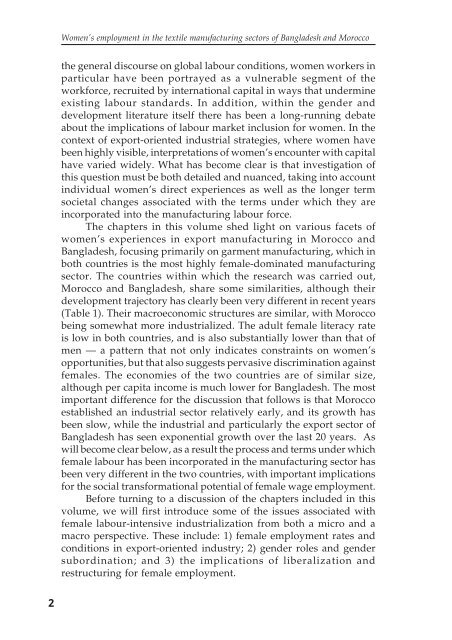Women's Employment - United Nations Research Institute for Social ...
Women's Employment - United Nations Research Institute for Social ...
Women's Employment - United Nations Research Institute for Social ...
You also want an ePaper? Increase the reach of your titles
YUMPU automatically turns print PDFs into web optimized ePapers that Google loves.
Women’s employment in the textile manufacturing sectors of Bangladesh and Morocco<br />
the general discourse on global labour conditions, women workers in<br />
particular have been portrayed as a vulnerable segment of the<br />
work<strong>for</strong>ce, recruited by international capital in ways that undermine<br />
existing labour standards. In addition, within the gender and<br />
development literature itself there has been a long-running debate<br />
about the implications of labour market inclusion <strong>for</strong> women. In the<br />
context of export-oriented industrial strategies, where women have<br />
been highly visible, interpretations of women’s encounter with capital<br />
have varied widely. What has become clear is that investigation of<br />
this question must be both detailed and nuanced, taking into account<br />
individual women’s direct experiences as well as the longer term<br />
societal changes associated with the terms under which they are<br />
incorporated into the manufacturing labour <strong>for</strong>ce.<br />
The chapters in this volume shed light on various facets of<br />
women’s experiences in export manufacturing in Morocco and<br />
Bangladesh, focusing primarily on garment manufacturing, which in<br />
both countries is the most highly female-dominated manufacturing<br />
sector. The countries within which the research was carried out,<br />
Morocco and Bangladesh, share some similarities, although their<br />
development trajectory has clearly been very different in recent years<br />
(Table 1). Their macroeconomic structures are similar, with Morocco<br />
being somewhat more industrialized. The adult female literacy rate<br />
is low in both countries, and is also substantially lower than that of<br />
men — a pattern that not only indicates constraints on women’s<br />
opportunities, but that also suggests pervasive discrimination against<br />
females. The economies of the two countries are of similar size,<br />
although per capita income is much lower <strong>for</strong> Bangladesh. The most<br />
important difference <strong>for</strong> the discussion that follows is that Morocco<br />
established an industrial sector relatively early, and its growth has<br />
been slow, while the industrial and particularly the export sector of<br />
Bangladesh has seen exponential growth over the last 20 years. As<br />
will become clear below, as a result the process and terms under which<br />
female labour has been incorporated in the manufacturing sector has<br />
been very different in the two countries, with important implications<br />
<strong>for</strong> the social trans<strong>for</strong>mational potential of female wage employment.<br />
Be<strong>for</strong>e turning to a discussion of the chapters included in this<br />
volume, we will first introduce some of the issues associated with<br />
female labour-intensive industrialization from both a micro and a<br />
macro perspective. These include: 1) female employment rates and<br />
conditions in export-oriented industry; 2) gender roles and gender<br />
subordination; and 3) the implications of liberalization and<br />
restructuring <strong>for</strong> female employment.<br />
2
















